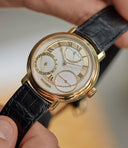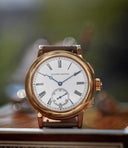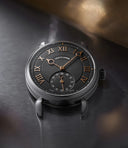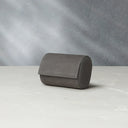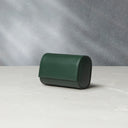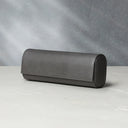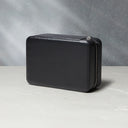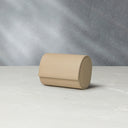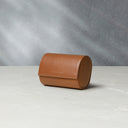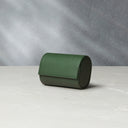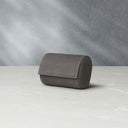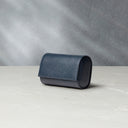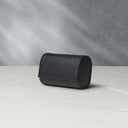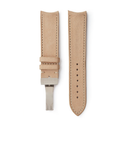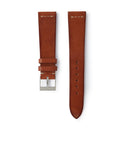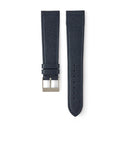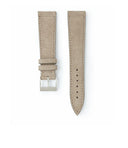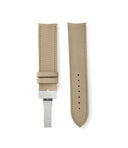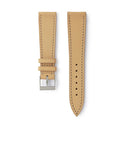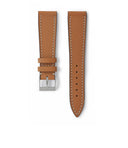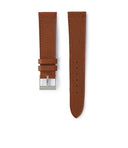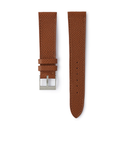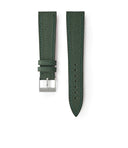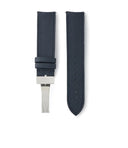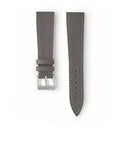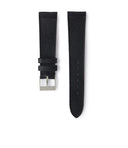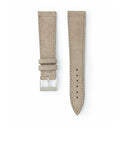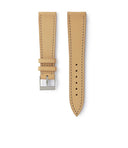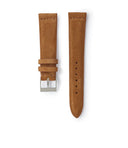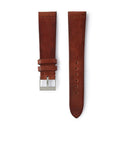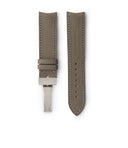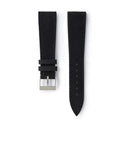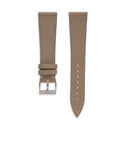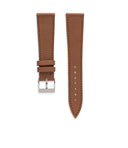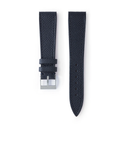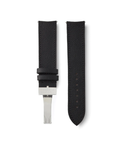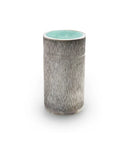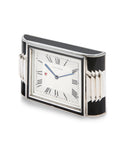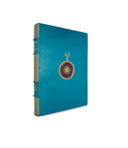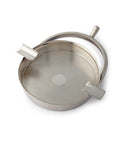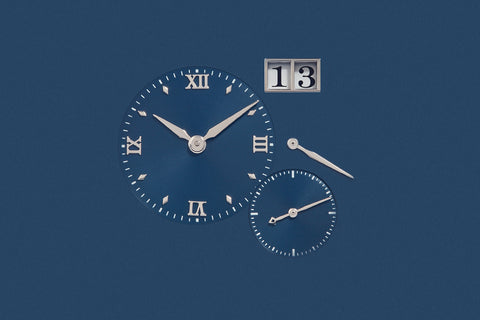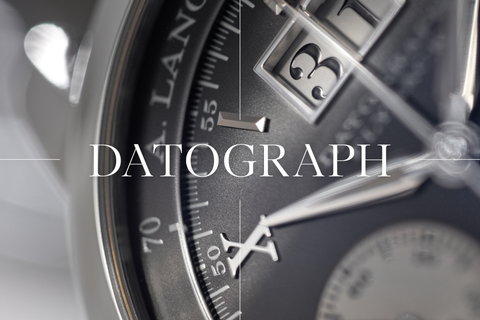The Langematik Perpetual collection was first introduced in 2001, in platinum and yellow gold. The watch was the first to combine a perpetual calendar with A. Lange & Söhne’s twin-window, panoramic date. Various editions have been released over the years, however – barring the three limited series examples – none are as rare as the reference 310.026E. Featuring a white gold case and attractive black dial, it was produced for only three years, between 2014 and 2017. Here is an example retailed in the last year of production.
The white gold case is robust yet classically proportioned in the Glashütte way. It measures 38.5m across and stands 10.2mm tall, in part due to the slimness offered by self-winding micro-rotor Sax-o-Mat calibre L922.1. The case is three-part in its construction. The rounded bezel meet the midcase in a flat facet, with a similar detail on the side of the exhibition caseback. While the bezel and flat facet of the caseback are polished, the midcase is horizontally satinated. It is home to the well-proportioned, fluted and signed crown as well as the three correctors for the perpetual calendar. An additional, and marginally larger, fourth corrector at 10 o’clock serves to advance all calendar displays in unison by increments of one. It is thoughtful acknowledgement of the challenge of having a perpetual calendar in a rotation of watches.
The lugs, marginally stepped from the midcase, taper and curve down. They have a marginal facet to them. Their 20mm distance is furnished with a black, alligator-grained leather strap secured by a signed, white gold pin buckle by specialist maker Brogioli.
The caseback rim, decorated with circular satination, bears engravings detailing the brand mark, place of origin, serial number and precious metal hallmarks. The caseback is secured by six flathead screws.
The dial expresses the full suite of perpetual calendar information in a thoughtful manner typical of the Glashütte maker. The black dial offers maximum contrast against the white metal of the case. On the outer edge lies a white printed chemin de fer track of minutes punctuated with luminous material corresponding to the hours. The applied Roman hours give way to markers at 4, 6 and 8 o’clock to accommodate the registers. The dial is stepped down to the portion where the calendar registers are located.
The registers have a sunburst quality to visually distinguish them and each expresses two scales of time. At 3 o’clock lies the month indicator that incorporates a yet smaller white register with the leap year indicator. Across this, at 9 o’clock is the day indicator. Within it is lies the bi-colour day/night scale with the hands for both these complications co-axially mounted. At 6 o’clock is both the seconds indicator and the moonphase display. The latter is built on a solid gold disk and is accurate to 122 years. The alpha-style hands used for all indications are filled with luminous material.
The date, likely the time scale most consulted after the time, is of the oversized, double window variety that is A. Lange & Söhne's signature.
The watch is powered by the self-winding micro-rotor Sax-o-Mat calibre L922.1, based on the family of L.921 movements designed by Helmut Geyer, a movement designer at the brand. The first Sax-o-Mat movement was created in 1997 and continued to be used in all automatic watches from the manufacture until 2011. The L922.1 features a gold rotor with platinum rim to add mass to the micro-rotor. The rotor wears relief engraving detailing the family of movements it comes from and the brand mark. The German silver plates and bridges are finished with Glashütte striping and the edges wear mirrored anglage. The balance bridge is adorned with hand-engraving, another A. Lange & Söhne signature, while the stainless-steel swan neck regulator and cap of the escape bridge are black polished. The screws are heat blued while the central pivot jewel features a gold chaton. The plates adorned with gold engraving detail the brand mark, serial number, jewel count (43) and that the movement is adjusted to five position, which is the chronometric standard.
The self-winding system offers 45 hours of autonomy. It features a useful zero-second reset mechanism – pulling the crown out springs the subsidiary seconds hand to the 12 o’clock position, allowing the wearer to accurately set the watch to a reference time.
The complete set includes original retail and warranty documents from 2017, as well as paperwork detailing a recent service. It also includes the outer and inner box which incorporates a winder for the automatic movement. Also included is the tool for the perpetual calendar correctors.
The Langematik Perpetual is perhaps singular in its proposition. It is one of the most wearable modern perpetual calendar watches, yet eminently modern and efficient. In this reference 310.026E guise it is all the more precious and rare.
































































































